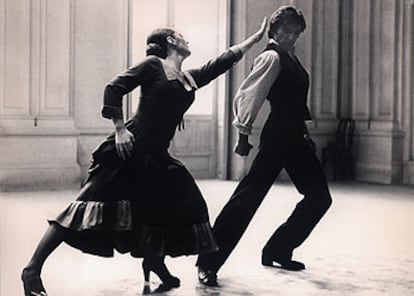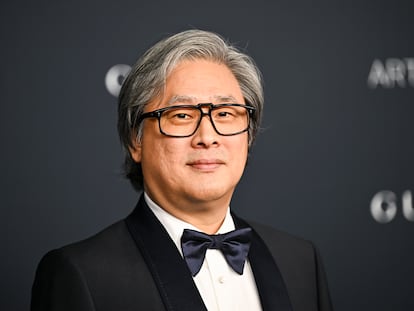Carlos Saura, the filmmaker who built a whole new language for dance
The Spanish director, who passed away on Friday at age 91, became famous for emotionally intense movies like ‘Blood Wedding,’ ‘Carmen’ and ‘Tango’ that brought flamenco and other styles into fresh focus

The relationship between Carlos Saura and dance began early and almost like a crush, as he himself explained it on several occasions. He was in his early 20s and had become the official photographer of the Granada International Music and Dance Festival. The son of a pianist mother, music was not an unknown art form to him, but dance was unfamiliar. Watching the dancers’ bodies move onstage at the festival, he was spellbound – and would remain so for the rest of his life.
Saura passed away on Friday at the age of 91, just a day before he was scheduled to receive an honorary lifetime achievement award at the Goyas (Spain’s equivalent of the Oscars). By then, he had become not just one of Spain’s most internationally acclaimed filmmakers, but also one inextricably linked to the world of dance through films like the 1983 Carmen and the 1998 Tango, both of which earned him Academy Award nominations.
Thus, he fell in love with dance through the lens of his camera, that extension of himself with which he looked at the world and built a universe of his own. It is easy to imagine Saura exploring this art form with the same fascination and admiration with which he always spoke of it. He discovered the effort and the discipline that are behind dance, but also the closeness and accessibility that it can entail, if you watch closely. In this sense, he made dance available to everyone with the kind of musical films that he cultivated. On a certain occasion, he expressed one of the most democratic and accurate ideas ever formulated about dance: that it is so broad in scope that there could be no one who was not a lover of it. “Everyone has a rhythm inside, either good or bad, but it is there,” he explained in 2021, when he was interviewed for the exhibition Carlos Saura and dance at the Fernán Gómez Theater in Madrid.
Flamenco and some of its main figures have been immortalized on the big screen through films such as Blood Wedding (1981), Carmen (1983) and El Amor Brujo (1985), a brilliant trilogy of Spanish musical cinema. Saura’s name is also closely associated with that of the dancer and choreographer Antonio Gades who, in the filmmaker’s view, represented the maximum expression of rigor and effort; Saura considered Gades his adviser. Undoubtedly, all three films are a jewel in his cinematographic crown, but also in the history of Spanish dance. After the overwhelming success of Blood Wedding and Carmen at the Cannes Film Festival (Carmen won the Palme d’Or for Best Film), Saura became the standard-bearer for a new way of making musical cinema. Robert Wise, director of West Side Story (1961), once told him: “You have invented another way of approaching dance through the camera.”
In the new cinematographic language that Saura invented for dance, two procedures stand out: on one hand, he introduced short-range, detailed shots that contrasted with the general shots to which American musical cinema was subjected; on the other, space and light became protagonists at the same level as the bodies in motion. And there was one more thing: Saura’s authentic passion as a dance spectator. “Sometimes, even though the take was good, I would ask for one more just so I could watch the dancers again,” he confessed last year in an interview for Spanish state broadcaster RTVE.
Other films such as Sevillanas (1991), Flamenco (1995), Tango (1998), Salomé (2002), Iberia (2005), Flamenco, flamenco (2010), Jota (2016) and The King of the World (2021) further evidence the influential signature of Saura, who used to watch the choreographies over and over again before deciding where the camera was going to focus. In his quest for a new discourse to express bodily movement, Saura became a cinematographic choreographer who built bridges for dance.
Sign up for our weekly newsletter to get more English-language news coverage from EL PAÍS USA Edition
Tu suscripción se está usando en otro dispositivo
¿Quieres añadir otro usuario a tu suscripción?
Si continúas leyendo en este dispositivo, no se podrá leer en el otro.
FlechaTu suscripción se está usando en otro dispositivo y solo puedes acceder a EL PAÍS desde un dispositivo a la vez.
Si quieres compartir tu cuenta, cambia tu suscripción a la modalidad Premium, así podrás añadir otro usuario. Cada uno accederá con su propia cuenta de email, lo que os permitirá personalizar vuestra experiencia en EL PAÍS.
¿Tienes una suscripción de empresa? Accede aquí para contratar más cuentas.
En el caso de no saber quién está usando tu cuenta, te recomendamos cambiar tu contraseña aquí.
Si decides continuar compartiendo tu cuenta, este mensaje se mostrará en tu dispositivo y en el de la otra persona que está usando tu cuenta de forma indefinida, afectando a tu experiencia de lectura. Puedes consultar aquí los términos y condiciones de la suscripción digital.
More information
Archived In
Últimas noticias
The new victims of the Republican war on Obamacare: Millions hit by soaring health insurance premiums
A country divided on migrant rights: Some US states expand protections while others restrict them
Venezuela authorizes the release of another 87 political prisoners
There is as much life left to discover on planet Earth as that which is already known
Most viewed
- David King, chemist: ‘There are scientists studying how to cool the planet; nobody should stop these experiments from happening’
- Reinhard Genzel, Nobel laureate in physics: ‘One-minute videos will never give you the truth’
- Oona Chaplin: ‘I told James Cameron that I was living in a treehouse and starting a permaculture project with a friend’
- Sinaloa Cartel war is taking its toll on Los Chapitos
- The Interoceanic Train, the Mexican alternative to the Panama Canal










































